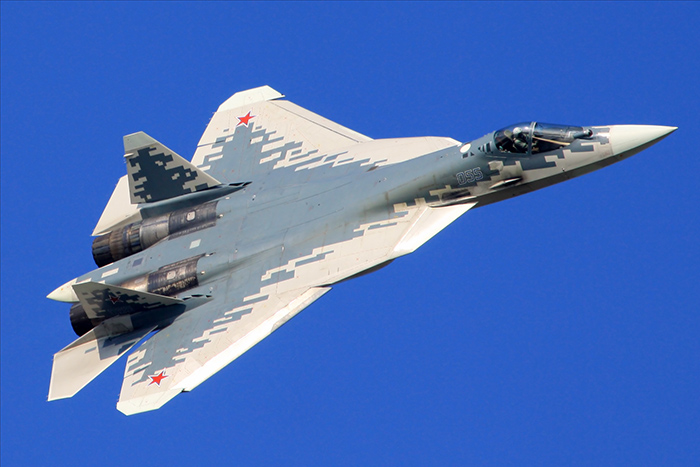
The first thing we want to inform our readers of is: in fact, the same aircraft passes under several names. Developer - Experimental Design Bureau. BY. Sukhoi uses the “proprietary” alphanumeric index “T-50”. Government agencies most often mention it in the context of the program "Prospective Airborne Complex of Frontline Aviation" (PAK FA). The Ministry of Defence assigned it the designation Su-57, moreover, the military speaks of “an aircraft of its original appearance” (with engines “Product 117”) and “aircraft with an engine of the second stage” (“Product 30”).
NATO countries use the code word Felon. And our Indian partners in military-technical cooperation have named the option considered for their own air forces - Fifth Generation Fighter Aircraft (FGFA).
The attention of visitors to the MAKS-2019 international aerospace salon on a static platform was presented to the Su-57E. The last letter indicates the export version of the machine, which has a number of differences from the base aircraft designed for the Russian Aerospace Forces (VKS). On the eve of the salon, a number of officials told reporters that the Su-57E received an export-issued passport and other documents permitting deliveries abroad.
Question about the series
Now, when the flight tests of the Su-57 “initial appearance” are close to completion, and the plant in Komsomolsk-on-Amur is assembling the first consignment, the issue of the series is of particular importance. The experience of modern aviation programs shows that for the payback of the project, the aviation industry needs to implement at least three hundred sales copies. So far, about eighty vehicles have been ordered through the Russian Ministry of Defence.
Therefore, the question now is the implementation of the Su-57E abroad. Foreign orders will help the manufacturer earn money in hard currency, increase serialisation and reduce the cost of a unit of final product. Also, with the availability of the series, it will be possible to develop, test and launch new versions of the aircraft. Thus, the Su-57 will receive an impetus for further development and the creation on its basis of the basic platform of a certain family of unified aircraft. Since projects of this kind stretch for decades, they allow for a long time to maintain a large number of jobs in the aviation industry and related industries.
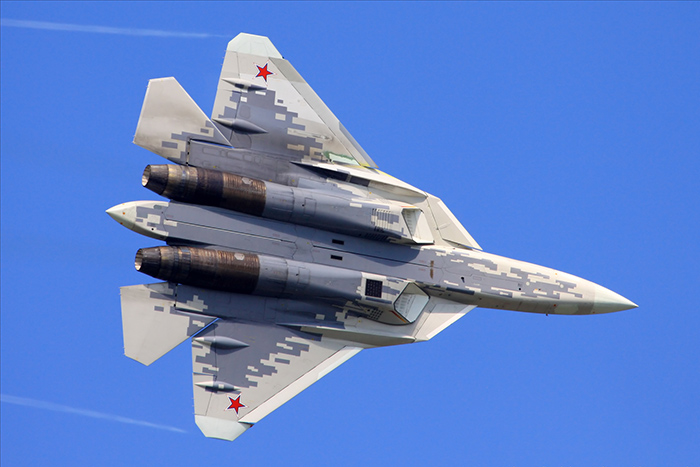
At the same time, fifth-generation aircraft are not just expensive, but also very expensive to operate aircraft, requiring developed ground infrastructure (including mandatory hangar storage) and also highly qualified maintenance. In addition, specially for such vehicles, new types of aviation weapons have been developed, which are suitable for placement in internal compartments by their mass-dimensional parameters. Consequently, fifth-generation aircraft can be found in demand only by a limited number of states with the corresponding capabilities.
Execution options
Note that the Su-57E and FGFA are different export options for the base aircraft. Firstly, the first is a single-seat aircraft, while the Indian Air Force for themselves considered the option with a crew cabin of two people. Secondly, the Su-57E is offered for delivery to all interested parties under the current rules of military-technical cooperation (MTC) with foreign countries, while the FGFA was offered for joint development by Russian and Indian specialists on an exclusive basis.
The decision to create a new export option, the Su-57E, was taken after India refused to continue the FGFA program last spring. Noting the huge market interest in fifth-generation fighters, Moscow abandoned the selective approach. The demonstration of the full-size model of the Su-57E at MAKS-2019 attracted the attention of a number of foreign delegations. Some asked the Russian side for more information on this aircraft. And they received it both directly at the aerospace salon, and at the end of the exhibition as part of bilateral meetings with representatives of the FSVTS and Rosoboronexport.
A number of media outlets, citing anonymous sources, report on the readiness of Algeria and Vietnam to purchase a dozen such aircraft. Note that this information has not yet been confirmed by government officials. Other interested countries also include Myanmar (Burma), Pakistan, Peru and others. In addition, some Indian military leaders informed reporters about the possibility of considering the direct purchase of a certain amount of Su-57E from Russia if the proposal was approved by the highest political leadership in Delhi.
India
Indian partners became the first, especially for which events were held on the latest Russian fighter. Six months after the first flight of the T-50-1, this aircraft completed a demonstration flight from the Ramenskoye airfield in the presence of envoys from a distant southern country. The descendants of the Kshatriya warriors praised the merits of the PAK FA and gave it the most flattering assessments.
Given the long-standing friendly ties between our states and the fact that the current stage of relations is characterized as a “strategic partnership”, Moscow has long offered Delhi exclusive rights to jointly develop an export version of the base aircraft, the FGFA. At the highest political level, a fundamental agreement was reached that the corresponding project will be implemented by the scientific and industrial enterprises of the two countries.
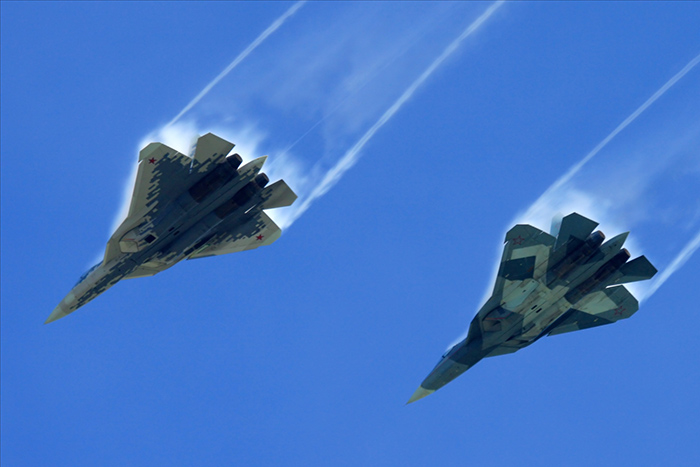
It was possible to reach mutually acceptable agreements and general project parameters, including financial ones. And also to conduct a quantitative assessment of the needs of the Indian armed forces, which were later supposed to be met by the joint efforts of Russian and Indian aircraft factories. However, Delhi demanded "equal participation", which, with all due respect to the Indian partners, was impossible due to the huge difference in scientific and technical potential and the experience gained in creating advanced aircraft models. The refusal to continue work on the FGFA came in April 2018.
At the same time, the possibility of direct purchase of a certain amount of Su-57E remains. True, this perspective is a rather distant future. So far, the Indian Air Force needs in aircraft are being met by supplying an additional (“about twenty”) number of Su-30MKI assembly kits to Hindustan Aeronautics Limited (HAL) and “over twenty” MiG-29s from stock. In addition, Delhi holds an international tender for the supply of 110 fourth-generation fighters, considering, including the Russian MiG-35.
Malaysia
Malaysia became the second country after India to receive Moscow’s offer to consider acquiring fifth-generation Russian fighters. Since 2013, the large-scale model FGFA has been exhibited at the stand of the United Aircraft Corporation (UAC) during various international exhibitions, including LIMA on the resort island of Langkawi.
The model attracted the attention of senior officials of the host country, including the then prime minister. Shortly after the opening ceremony of LIMA’2017, Najib Tun Razak and his entourage visited the Russian exhibition, paying attention to this exhibit. Without hesitation, they were invited to consider the new aircraft as a replacement for the previously delivered fourth-generation fighter MiG-29N.
Speaking at one of the recent economic forums of the Asia-Pacific region (APR), the current Prime Minister Mahathir Mohamad expressed dissatisfaction with the actions of the West and the desire, in the case of continuing the established practice, to purchase the necessary aviation equipment in Malaysia in Russia.
We note that Mahathir, who enjoys the great support of the masses, again, after a long break (2003-2018), returned to governing the country. Earlier, on his instructions, the MiG-29N and Su-30MKM fighters were purchased for the national armed forces, and the issue of modernising the aircraft of the system or replacing them with more modern ones is currently being considered.
Turkey
The next case of public interest in a fifth-generation Russian fighter from a senior foreign delegation was noted during the MAKS-2019 air show. Immediately after the opening ceremony on August 27, the presidents of Russia and Turkey headed for the Su-57E and talked for a long time on the plane. Vladimir Putin suggested to Recep Tayyip Erdogan to consider buying options for Russian aircraft, naming the following types of fighters: Su-57E, Su-30SM, Su-35S and MiG-35.
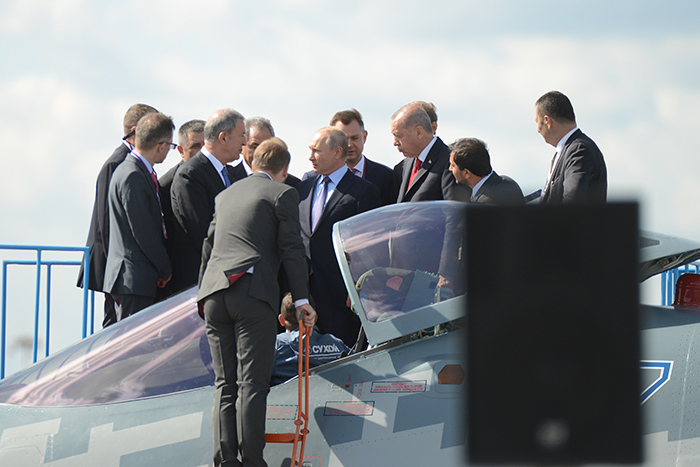
Among the officials accompanying the Turkish president was Defence Minister Hulusi Akar. He also read with interest the Su-57E, carefully examined the cockpit and exchanged views on what he saw with his Russian counterpart Sergei Shoigu. Then the members of the Turkish delegation watched the demonstration flights, in which, along with other types of aircraft, the four Su-57 participated.
Toward the end of the year, Turkish newspapers published a series of articles that talked about negotiations between our countries on the sale and purchase of the Su-35S and Su-57E. According to one source, Ankara is leaning toward the first option (purchasing 24 Su-35S), mainly based on the ability to quickly obtain commodity samples.
They are necessary in connection with Washington’s last year’s decision to exclude Turkey from the F-35 program and to refuse to supply it even with finished samples located at US air bases (Luke AFB and others) and circled there by Turkish pilots (not to mention the entire batch of thirty units). Because of this, long-term plans to renew the fleet of the National Armed Forces (TKS) to replace the obsolete and physically worn-out “phantoms” (about fifty units) are frustrated.
Meanwhile, the local press gives serious arguments in favor of the Su-57E variant. As you know, the Turkish industry has long mastered the production of F-16C and assembled several hundred such machines, both for its own armed forces (232 units) and third countries (for example, Egypt). The continuation of the licensing program, which (in any case, so far) does not fall under US sanctions, solves the problem of replacing the F-4E / RF-4E, even if the F-16 belongs to light fighters, but a “phantom” (like the Su-35C ) - to heavy.
By purchasing the Su-57E, Turkey can gain access to the high Russian technologies that are needed by local industry to implement its own fifth-generation fighter project, the first flight of which is expected in 2025. The full-size mock-up of the Turkish TF-X aircraft (Turkish Fighter - Experimental) was first exhibited at last year's Paris exhibition in Le Bourget.
The following consideration: Moscow, to a much greater extent than Washington, is ready to conduct joint projects with Ankara in the field of aviation technology, including the completion of basic types of aircraft for the specific requirements of TKS. Thus, Turkish firms have a chance to install the equipment they created as part of the F-35 program on Russian platforms. And, thereby, to avoid large financial losses caused by the termination of their participation in the American project.
China
People's Liberation Army of China (PLA) from 1991 to 2012 received from Russia about one hundred and eighty Su-27SK / UBK and Su-30MKK / MK2. As well as several hundred J-11, J-15, J-16, etc., created by local aircraft manufacturers based on Russian counterparts. Almost five years ago, Beijing signed a contract for Su-35S multipurpose fighters, whose deliveries ended in the fall of the year before last.
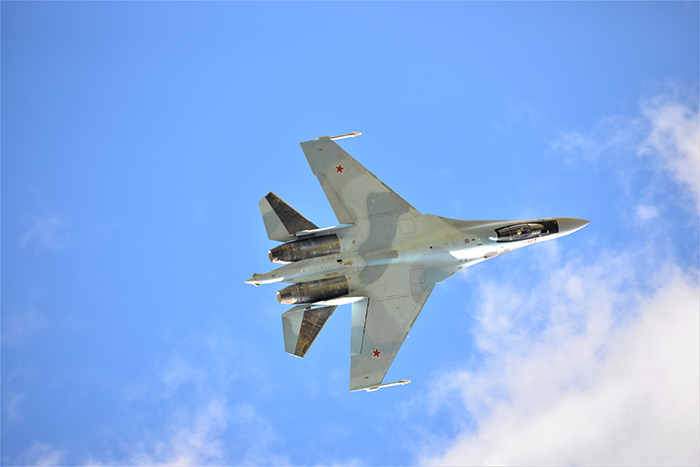
On the pages of the foreign press you can find the words spoken by Viktor Kladov - Director for International Cooperation and Regional Policy of Rostec State Corporation. Communicating with reporters at one of the international exhibitions, he, in particular, said that within a couple of years after the completion of supplies of the Su-35S, our partners from the Celestial Empire have to make a decision either in favour of purchasing an additional batch of such aircraft, or acquiring more advanced Russian aircraft . If Beijing chooses the second option, then the chance of a Su-57E is great, he suggested.
Here, the interests of Beijing and Ankara coincide - to gain access to high Russian technologies that are superior to their own. Indeed, Russia is ahead in such important areas as: engine building, electronics, countermeasures and defeat. This is what attracts the attention of importing countries to such modern machines as the Su-35S and Su-57.
The public demonstration of the Su-57E at MAKS-2019, to the accompaniment of statements by Russian officials about their readiness to export it, attracted the attention of Chinese media. Several resources, including English ones, posted articles on the new Russian aircraft, comparing it to a fifth-generation Chinese fighter J-20. According to media reports, about twenty "twenty" have already entered service with the PLA Air Force.
State television has released a series of reports from the military unit, where servicemen proudly show their latest aircraft technology to veterans. Somewhat earlier, the same resource told its viewers about the successful development of fighter aircraft of the Su-35 type by pilots and technicians of the PLA Air Force. A rhetorical question: would the Chinese begin to purchase 4+ generation fighters in Russia if they really had all the necessary technologies for fifth-generation aircraft?!
Meanwhile, recent publications in the state-owned media of the Middle Kingdom indicate the need to continue the practice of procurement of advanced weapons, such as the Su-35S and Su-57E, in Russia. It is noted that the “drying” possess such distinctive qualities as “over-manoeuvrability”, which allows them to successfully conduct close air combat with any known enemy aircraft. These and similar arguments of Chinese journalists inspire hope that the PLA will continue to update its fleet in the foreseeable future by acquiring aircraft from both national industry and the Russian aviation industry.
Indonesia
Indonesia sequentially purchased several shipments of Su-27SK and Su-30MKK / MK2, and in February 2018, it signed an agreement on eleven Su-35S with a total value of more than a billion dollars. However, while the implementation of this transaction is delayed due to Washington’s threats to apply the measures prescribed in the Countering America Adversaries through Sanctions Act (CAATSA), the translation is “Countering America’s Adversaries through Economic Sanctions”. It was adopted by Congress and signed by President Trump in 2017.
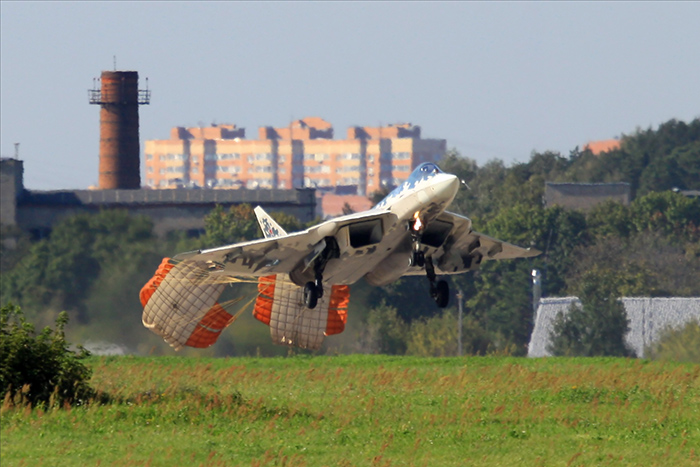
So far, the only case of practical application of CAATSA is known - several Chinese politicians and military leaders responsible for the purchase of Su-35S and S-400 in Russia fell under sanctions. Meanwhile, Washington threatens them with India, Turkey, Egypt, Iraq, Indonesia and other countries of the world. While Beijing, Delhi and Ankara answered in a harsh tone, other capitals so far prefer to remain silent. And the Indonesian ambassador told reporters that the implementation of the contract “depends on the technical details”, noting the complex nature of the deal, where the fighters are only part. Earlier, the country paid for Russian military equipment with counter deliveries of goods of traditional export, including palm oil and rubber.
An alarm bell rang in mid-January when the French press wrote (for example, here: https://www.latribune.fr/entreprises-finance/industrie/aeronautique-defense/et-si-l-indonesie-s-offrait-des-rafale-et-des-sous-marins-scorpene-837339.html)) about the desire expressed by the Government of Indonesia to acquire up to 48 Rafale fighters. However, French fighters are quite expensive, and it is not yet clear how they are going to pay for them. It is unlikely that official Paris and Dassault will agree to the same conditions that had previously been applied to the acquisition of Russian equipment. According to press publications, the first four Su-27SKs were paid with "real money" by only 15%. And yet, in our opinion, Washington’s threats can only delay execution, but not cancel the already concluded contracts for the supply of Russian weapons.
Other Asia Pacific countries
Since the Su-57E belongs to heavy fighters, it will be logical to assume the supply of mass-produced aircraft primarily to those countries where aircraft of this dimension are already operating. As you know, in addition to Malaysia, India, China and Indonesia, Su-27/30 family aircraft fly in Vietnam.
Washington, of course, could try to threaten Hanoi with economic sanctions in the case of the purchase of the Su-57E. However, the history of relations between the two countries is full of examples of how the Vietnamese unequivocally responded to manifestations of foreign interference in the affairs of their country.
It is unlikely that CAATSA threats could intimidate Myanmar (Burma). This country has never previously operated heavy-class fighters, but only expects the delivery of the Su-30SM. This type of aircraft was mentioned a couple of years ago in the context of the official visit of Sergei Shoigu to Naypyidaw and his negotiations with the Chief General of the Republic of Myanmar Armed Forces, Senior General Min Aung Hlein. If the supplies of the Su-30SM take place, then it will be more logical for the Burmese military to focus on this type.
Among other Asia-Pacific countries - Russia's traditional partners in military-technical cooperation, light-class fighters of the MiG-29 type operate: India, Myanmar, Malaysia, Sri Lanka, Bangladesh, North Korea and Mongolia. Prospects for the supply of Su-57E to the last four are extremely low, based on the economic capabilities of these states. As the events of recent years show, small countries prefer simpler cars. For example, combat training aircraft such as the Yak-130 - they are already being delivered to Myanmar, Bangladesh and Laos. Demand in these countries may also find the MiG-35, which is noticeably lighter and cheaper than the Su-57E.
The rest of the world
There are several other non-CIS countries that traditionally prefer Russian weapons. In our opinion, the Su-57E is of interest to Venezuela, Iraq, Iran, Algeria and Egypt. True, the first couple in the list is in an extremely difficult political and economic situation due to well-known events. However, based on the huge reserves of hydrocarbons, it has enough resources to recover and raise funds for fifth-generation aircraft closer to the end of this decade. Moreover, by that time there will be a need to replace previously acquired F-16 aircraft.
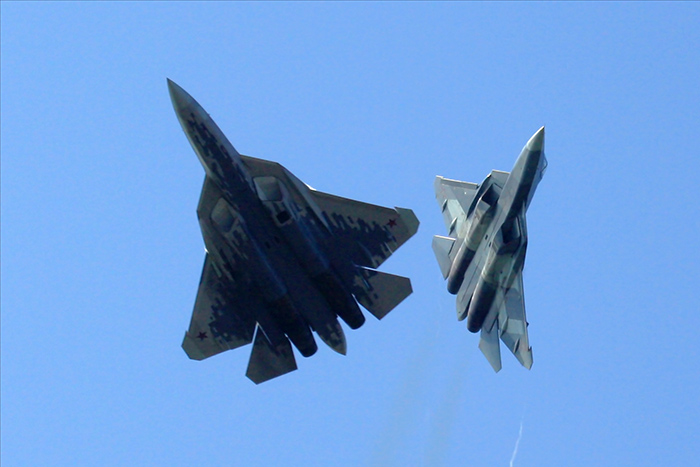
Algeria also holds large hydrocarbon reserves. This circumstance allows him to allocate significant financial resources for the acquisition of advanced military equipment in Russia. Among the supplies of recent years are Su-30MKA, Yak-130, S-300 Favorit air defence systems, etc. Despite difficult internal political processes and changes in the country's leadership, Algeria remains one of the largest importers of Russian weapons.
Unlike other countries in the Arab East, Egypt, by contrast, is an importer of oil and natural gas. At the same time, the country has large labor resources and enjoys the financial support of the rich countries of the Persian Gulf. This allows Cairo to spend significant funds on the armed forces. Recent deliveries from Russia include MiG-29M2 fighters, Ka-52 helicopters, S-300B4 anti-aircraft missile systems, Rezonans-NE long-range radars, etc. Recently, a decision was made to purchase a Su-35 batch.
Iran also expresses a desire to purchase modern fighter jets from Russia, and, from the lips of individual officials, it sounded - the Su-30MKI. The armed forces of the Islamic Republic have long operated heavy-class fighters of the F-14A and F-4D / E type, as well as Su-24 front-line bombers. In addition, light fighter MiG-29, J-7 (MiG-21), Mirage F1 and F-5 are in service. Many of the aircraft of these types will soon become a joke to develop a resource. Purely technically, the Su-57E is a good replacement for outdated American cars, and in size it fits in numerous hangars built for "Tomcat" and "Phantoms".
Tehran sees in advanced complexes of Russian origin a means of protecting national sovereignty and deterring an aggressor equipped with American weapons. Recently, he acquired in Russia S-300PMU-2 Favorit anti-aircraft missile systems and a number of advanced radar systems, on the basis of which a unified air defence system of the country is being created. This year, the UN ban on the supply of offensive weapons to the country expires, which opens up new opportunities for the development of military-technical cooperation with Iran.
In a word, there are enough countries in the world that are interested in the topic of acquiring the Su-57E. And most importantly, they have sufficient financial and human resources, both in terms of acquiring and maintaining the airworthiness of a group of such machines.











